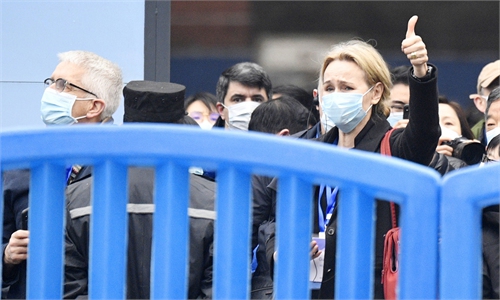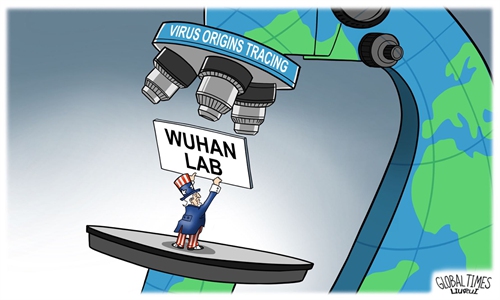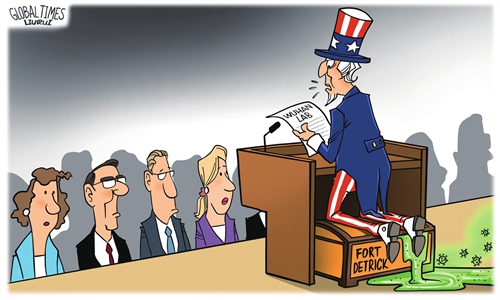Exclusive: Chinese leader of WHO-China joint expert team says 2nd-stage probe should focus on earlier suspected cases around the world
Exclusive: Chinese leader on WHO-China joint expert team says 2nd-stage probe should focus on earlier suspected cases around the world
Editor's note:
Three months after US President Joe Biden requested a more in-depth review of the origins of novel coronavirus, the US intelligence community released an unclassified report, which showed that the community was split on the origins and offered no conclusive answers.
During the past three months, the US has been hyping the "lab leak" theory and has launched what Chinese experts termed a "political war" against China to smear the country as the "source of the coronavirus disease" in an attempt to "consume China's diplomatic resources" and "contain China's rising influence in the Asia-Pacific Region." In an exclusive interview with the Global Times(GT), Liang Wannian, team leader of the Chinese side of the WHO-China joint expert team, reiterated that the Wuhan Institute of Virology (WIV) had never contacted, stored, or studied any novel coronavirus before December 30, 2019. It had also never designed, manufactured, or leaked the novel coronavirus. He suggested that for the second-stage investigation, the WHO should carry out research in countries where earlier suspected cases had been reported or where novel coronavirus was detected in samples earlier than the Wuhan outbreak. A retrospective study on international logistic companies and frozen food suppliers for the Huanan seafood market in 2019 might be another clue. The scientist criticized the US intelligence agencies' probe of a scientific issue, stressing the probe should be conducted with scientists as the main reference body and evidence as the basis.
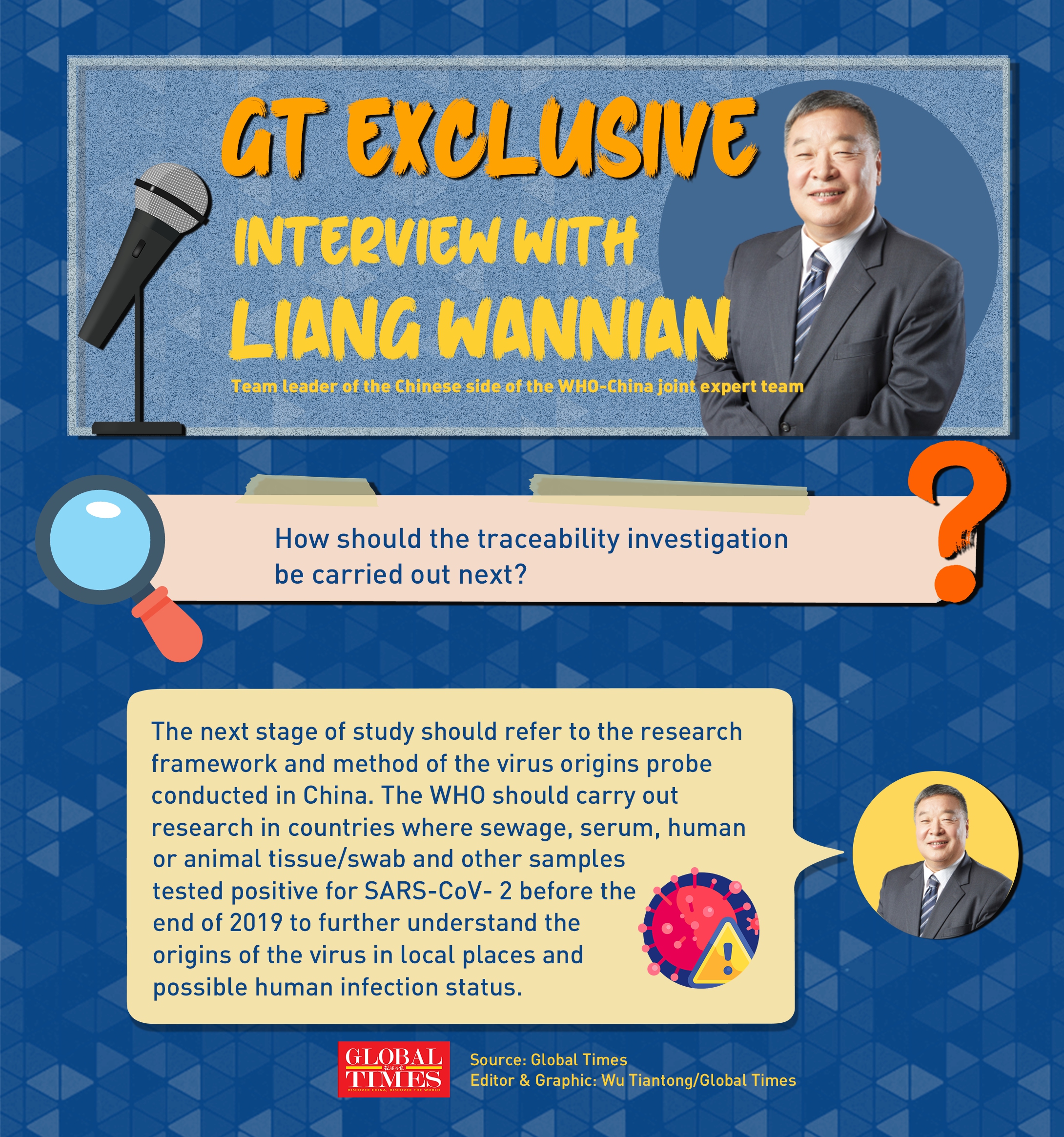
GT: On August 2, Representative Michael McCaul, Lead Republican of the US House Foreign Affairs Committee, released a report claiming that there is a preponderance of evidence that the virus leaked from the Wuhan Institute of Virology (WIV) sometime before September 2019. It also alleged that the WIV, aided by US experts and Chinese and US government funds, were conducting gain-of-function research. Do you have any comment on this allegation? What do you want to stress about the various versions of the "lab leak" conspiracy?
Liang: As far as I know, the report is not in accord with the actual situation in the WIV. In January, the WHO-China joint expert team visited the WIV and carried out thorough exchanges with the institute's experts. There was a detailed communication in bat coronavirus research and other advanced study programs. The WIV has not done any research on gain of function (GOF), which makes viruses more virulent.
From what I know, the WIV had never contacted, stored, or studied novel coronavirus before December 30, 2019. It also has never designed, manufactured, or leaked novel coronavirus. So far, the staff and researchers at the institute have maintained "zero" infections. The joint expert team concluded that lab leak is extremely unlikely.
GT: Previously you have mentioned that "we cannot rule out the possibility that new evidence will emerge. Some countries believe that further investigation should be conducted in this area, so it should be carried out in labs other than the WIV that have not been investigated before." Recently, the Chinese Foreign Ministry repeatedly called on the US to answer four questions and explain the mysteries related to the early COVID-19 cases, Fort Detrick lab, the Wuhan Military Games, and e-cigarette pneumonia. Do you think it is necessary to further investigate these mysteries in the US?
Liang: Tracing the origins of the virus is a scientific issue and scientific work should be based on evidence. If there is evidence, it is necessary to investigate. This principle should be followed by all countries in the world. In July 2020, a WHO task team came to China to finalize the outline for the virus origins probe's China part. At that time, we reached a consensus that traceability is a scientific work, which is very complicated and may not be accomplished overnight. It requires long-term efforts, orderly and effective implementation, and global cooperation. To trace the origins, we should not focus on a particular place or time, but on a global perspective. With global coordination, we should push forward the probe in a focused and planned way.
GT: Many political parties and scientists advocate that the probe on virus origins should be carried out in multiple countries and locations around the world under the guidance of the WHO, especially in the US. In your opinion, how should the traceability investigation be carried out next? As there are a number of findings suggesting that novel coronavirus infections may have occurred in many parts of the world earlier than previously thought. What inspiration do you think these findings provide for the follow-up probe?
Liang: We suggest that the second-stage traceability work should be carried out in a fair and equitable manner on the basis of the first-stage result, and countries should strengthen exchanges and cooperation. The probe on virus origins should be conducted with scientists as the main reference body and evidence as the basis.
The scientific discovery of the first stage probe in China provides a research basis for conducting similar tracing work in other countries. China's proposal describes the scope of the next phase of research under the global framework, the main guiding principles of relevant research and the main expected results.
Currently, with continuous research by scientists from various countries, more and more evidence is proving that Wuhan may not have been the first place where the novel coronavirus made the animal-to-human jump. China suggests the WHO conducting analysis on earlier suspected cases that have been published, as well as earlier evidence found in animal and environment samples, so as to further determine the scientificity and reliability of the available evidences. It is also necessary to organize experts to carry out in-depth assessment of novel coronavirus evolution and global viral gene editing techniques to determine whether there is a possibility of artificial synthesis of novel coronavirus.
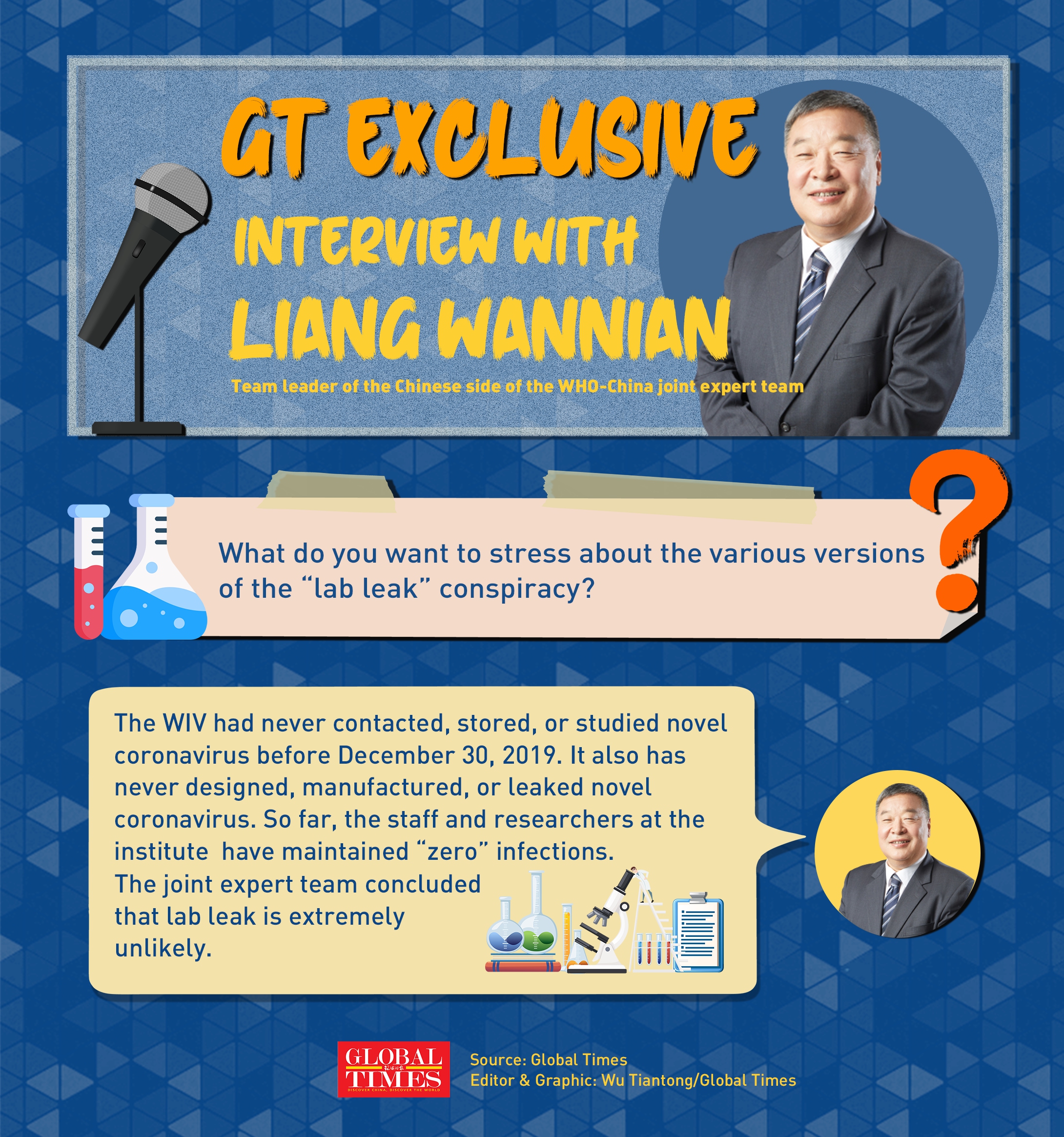
The next stage of study should refer to the research framework and method of the virus origins probe conducted in China. The WHO should carry out research in countries where sewage, serum, human or animal tissue/swab and other samples tested positive for SARS-CoV- 2 before the end of 2019 to further understand the origins of the virus in local places and possible human infection status. Some of the research may have been partially completed or documented. Therefore, the second-stage research should build on existing information, reinforce the work rather than duplicate ongoing or existing work.
Whether it is early cases, biological samples, gene sequences, natural hosts, intermediate hosts, or cold chains, it is necessary to carry out joint research in many countries, many places around the world. Understanding the processes how the virus made cross-species transmission and then spread globally requires an in-depth understanding of the diversity and evolution of the virus in animal hosts, the interactions between animals, the environment and humans, as well as the factors that contribute to efficient human-to-human transmission. To ensure continuity of the research, the expert team should take full account of the involvement of experts in the first-stage study in order to support further joint research on the suspected origins of the virus.
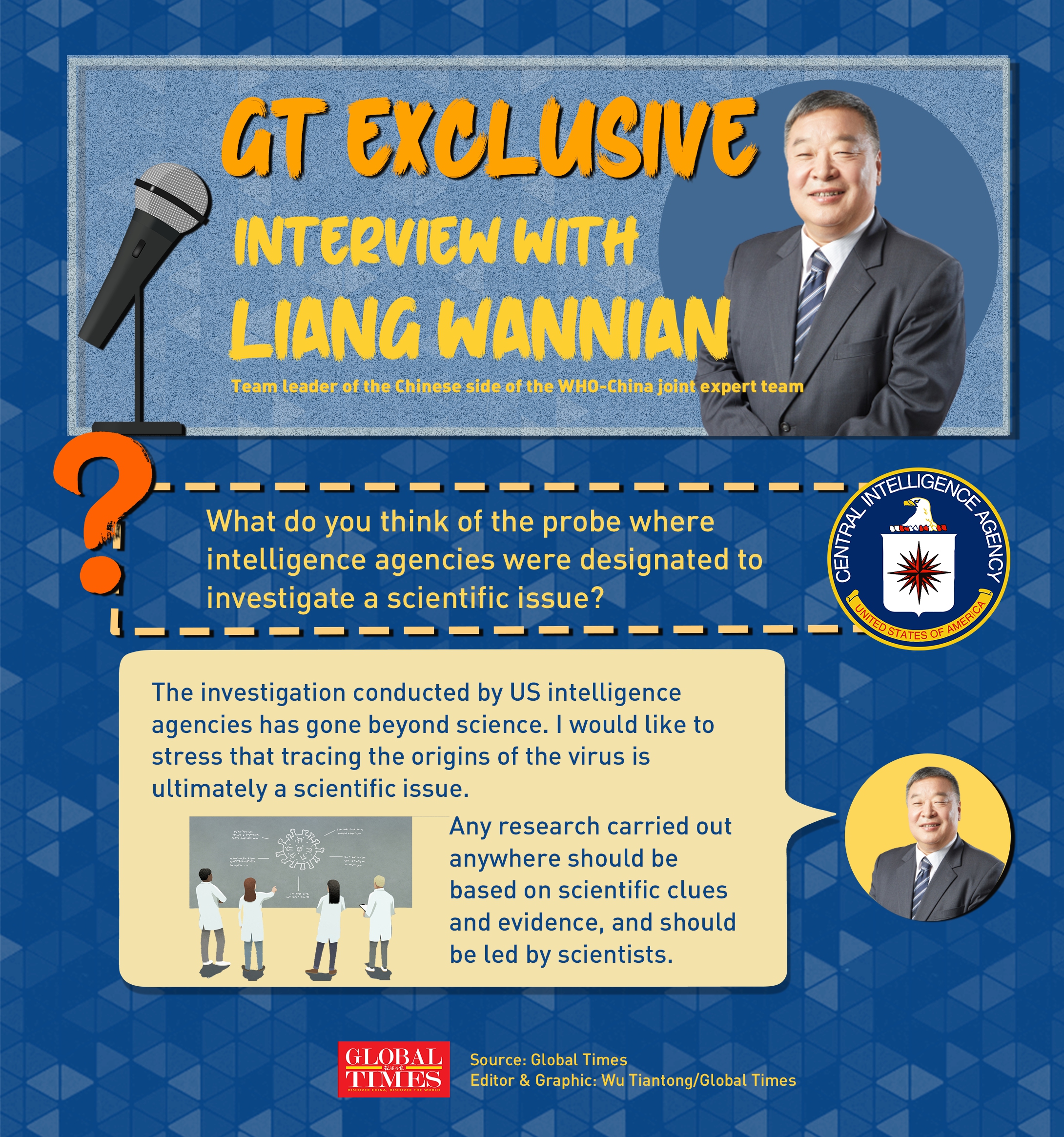
GT: US President Joe Biden has asked intelligence agencies to confirm within 90 days whether the virus came from a lab. He has also asked for a second investigation into China. What do you think of the probe where intelligence agencies were designated to investigate a scientific issue and the US' call for another round of investigation into China?
Liang: The investigation conducted by US intelligence agencies has gone beyond science. I would like to stress that tracing the origins of the virus is ultimately a scientific issue. Any research carried out anywhere should be based on scientific clues and evidence, and should be led by scientists. Blindly politicizing the issue of virus traceability does no good to the advancement of the traceability research. I hope that the international community will truly take the traceability work as a scientific issue, get rid of political interference, actively and steadily promote the continuous traceability in many countries around the world, strengthen scientific cooperation and exchanges on traceability, and do its utmost to prevent the re-transmission of similar viruses in animals and humans in the future.
GT: According to an academic report recently published by nine scientists, as a hub of international communication, Wuhan received extensive international flights from cities around the world before the SARS-CoV-2 pandemic. Notably, many of these flights to Wuhan departed from Southeast Asian countries that overlap with the Rhinolophus and pangolin distributions, as well as multiple known sarbecoviruses. The WHO-China joint study report also says that there is a possibility of novel coronavirus introduction through the cold chain/food. Therefore, before the pandemic, Wuhan was already at high risk of importing SARS-CoV-2 through cold-chain cargo from other parts of the world. How do you assess the "high risk"?
Liang: China first detected that the novel coronavirus can be transmitted at long distances via cold chain transports. The detection is based on the epidemiological research in the Xinfadi outbreak in Beijing on June 11, 2020. The analysis showed the infection was traced to the wholesale market in Beijing's Xinfadi. Nucleic acid testing on samples from market environment, staff and their close contact personnel, the testing of vendor employees' serum antibodies, the traceability of on-sale imported frozen food, and the genetic sequencing of the positive samples show that the virus strain that caused the outbreak was imported from countries or regions outside China, and that the cold chain may be a new vector of virus transmission.
Another outbreak occurred in Qingdao, East China's Shandong Province in October 2020. The first two patients were dock workers at the port who had no travel history or contact history with confirmed COVID-19 cases. The only epidemiological link that can be established with the two cases was the novel coronavirus exposure to the surface of the external packaging of imported cold-chain food. Subsequently, the Chinese Center for Disease Control and Prevention isolated the novel coronavirus from the outer packaging of frozen food in Qingdao, proving that the cold chain is one of the sources of transmission of novel coronavirus.
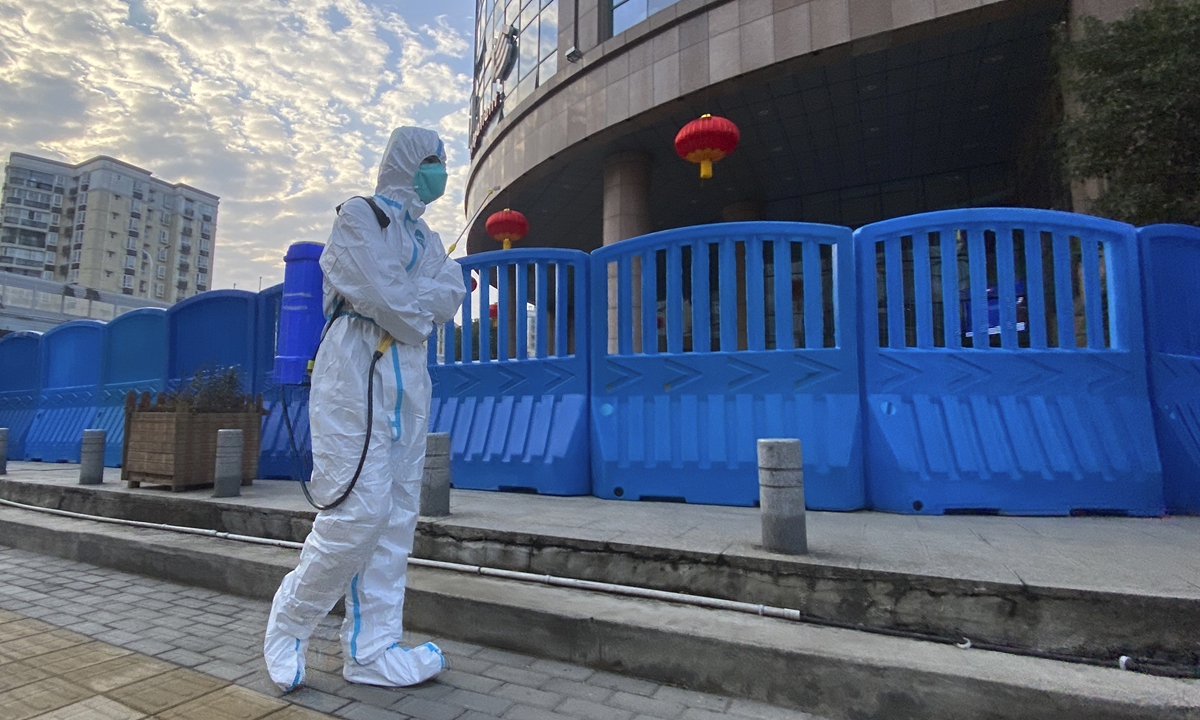
At the beginning of the outbreak, we had no such understanding. Therefore, we had never thought of the cold-chain possibility in sampling and testing. Now, looking back, just like the consensuses reached by the WHO-China joint expert team, the early outbreak in Huanan seafood market in Wuhan might have been triggered by cold-chain food.
The study on cold-chain transmission should be carried out globally in the next step. A retrospective study should be conducted on international logistic companies and frozen food suppliers for Huanan seafood market in 2019, including nucleic acid testing of stock samples and serum testing of workers involved. The next-step study should also further complete the evidence chains to demonstrate the role of the cold chain in the introduction and spread of viruses and analyze the persistent viability and infectious activity of the virus under logistics conditions.
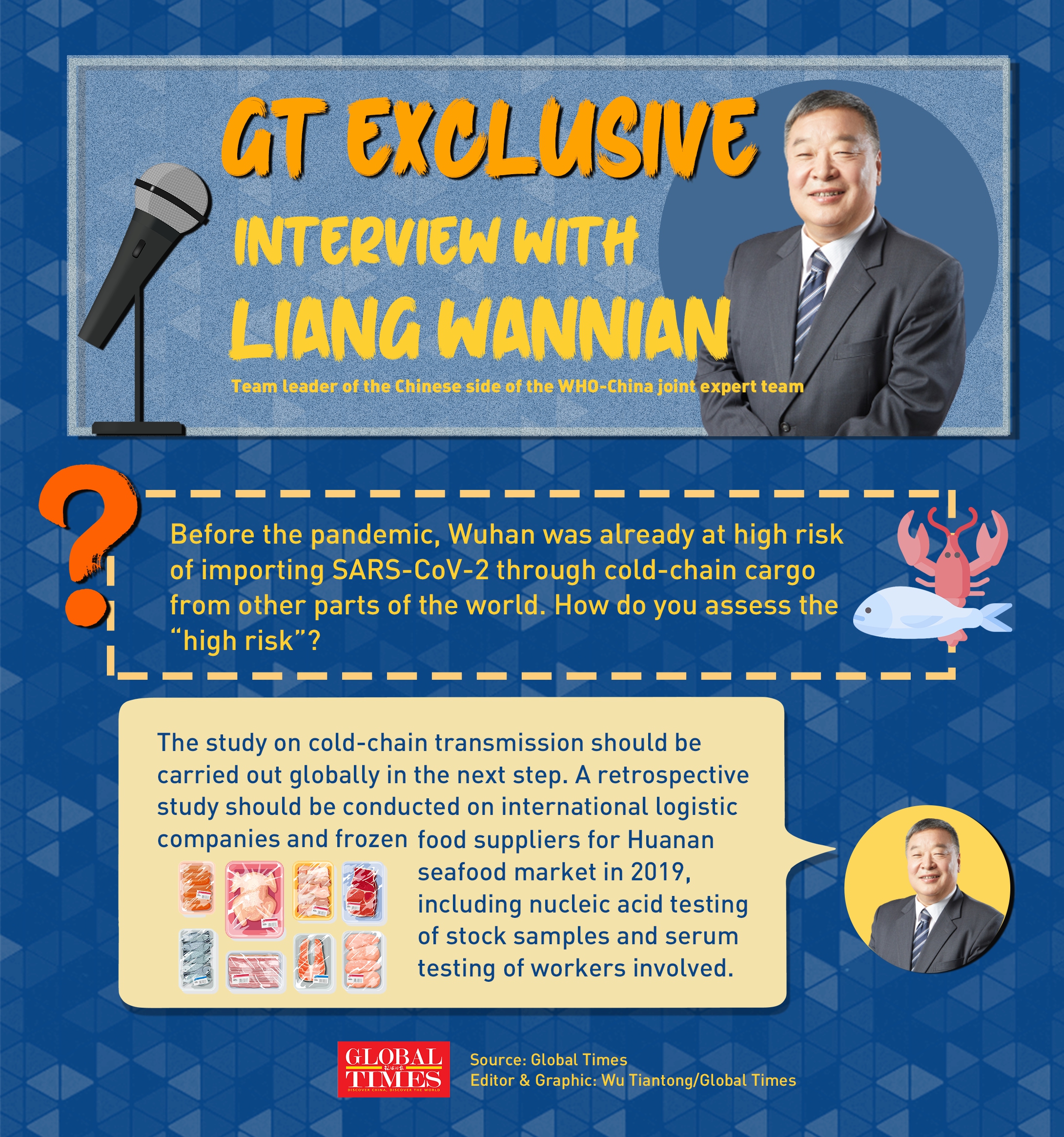
GT: After finishing the first phase of virus origins tracing work, experts considered that the lab leak theory is "extremely unlikely." However, WHO chief Tedros said that all hypotheses are still open and need further analysis. In other words, the lab hypothesis has not been ruled out. What do you think about this?
Liang: With an objective and comprehensive scientific attitude, we considered the lab leak hypothesis when we made the scientific design. When evaluating each hypothesis, we listed the arguments in support of this hypothesis and against this hypothesis. Based on these arguments and evidence, experts evaluated them again. Regarding the lab hypothesis, we listed the evidence supporting laboratory leaks: We have seen lab leaks of viruses in other parts of the world in the past. But we still have a lot of evidence against this hypothesis: The lab hypothesis includes two parts; one is man-made; and the other is lab leak. The first one was ruled as impossible by scientists. About the other one, a basic premise of a lab leak is that the Chinese lab had previously stored the virus.
We went to the Wuhan Institute of Virology and visited its P4 laboratory during the field studies of the WHO-China joint team in Wuhan. Together with the management and staff of WIV, we discussed the lab hypothesis, including lab access, personnel qualification and evaluation, research content approval, experimental operation and supervision, facility and equipment operation, disposal of waste, and health monitoring and other aspects of the implementation of the management system.
We also carefully discussed their research on the bat-related coronavirus and other advanced research projects. The joint expert group agreed that it's impossible that the virus was leaked from that lab. The lab has strict management and has not carried out research on this virus; from the published research, there is no virus close to it. The records of our visit to the WIV are detailed in a special chapter in the joint report.
When the joint team evaluated these hypotheses, it adopted a systematic approach and analyzed them in a rational way. We carefully analyzed some of our existing evidence and data. Some people have mixed personal feelings or personal subjective judgments, probably citing the incidents of lab leaks in certain countries, or some people have made mistakes while working in labs, so they presumed that the SARS-CoV-2 was leaked from the lab. I think it's totally unreasonable.
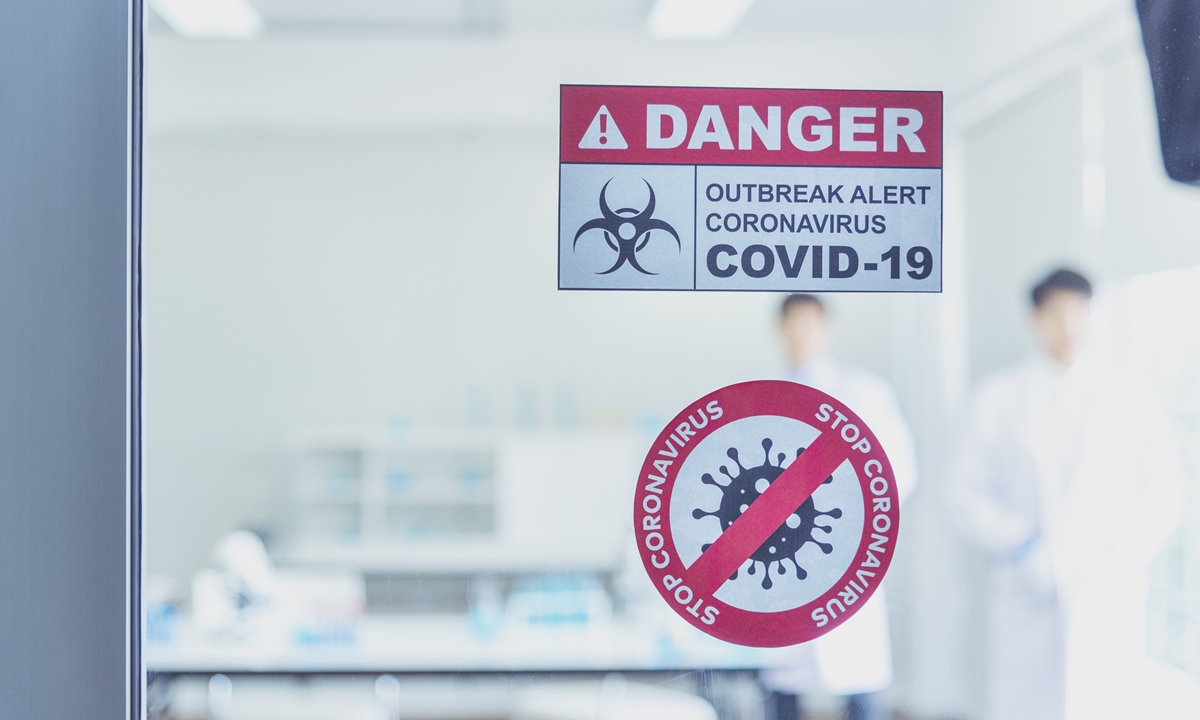
GT: What is the biggest obstacle for international experts and WHO to reach an agreement on the second-phase origins-tracing work? As a representative of Chinese experts, what would you like to say to scientists in other countries or those who are under political disturbance or pressure?
Liang: Origins-tracing work for emerging infectious diseases has a long way to go, and it is extremely difficult to find the source of the virus.
In history, it took 10 years to pinpoint the horseshoe bat as a possible natural host of SARS. The MERS virus found in Saudi Arabia in 2012 caused outbreaks in many countries, and the hypothesis of its origin is still animal to human transmission. The initial origins-tracking work focused on bats. Later, evidence of infection was found in camels. It is currently speculated that the path of infection of the virus is bat-camel-human, but the true origin is still unclear. We still lack the evidence of the chain of transmission.
The Ebola virus, discovered in 1976, is still causing outbreaks in some countries in Africa. Research on the virus has been carried out for decades. Although more and more evidence points to animals such as orangutans and bats, the specific animal origin is still an unsolved mystery.
Past experience tells us that the tracing of the source of SARS-CoV-2 cannot be accomplished by formulating a short-term plan. It requires a long-term plan involving multiple subjects and fields, and requires joint efforts and cooperation from multiple parties. Viruses are the common enemy of mankind. Only by working together and advancing on the path of science can we make progress and protect the health and well-being of all mankind.
Three months after US President Joe Biden requested a more in-depth review of the origins of novel coronavirus, the US intelligence community released an unclassified report, which showed that the community was split on the origins and offered no conclusive answers.
During the past three months, the US has been hyping the "lab leak" theory and has launched what Chinese experts termed a "political war" against China to smear the country as the "source of the coronavirus disease" in an attempt to "consume China's diplomatic resources" and "contain China's rising influence in the Asia-Pacific Region." In an exclusive interview with the Global Times(GT), Liang Wannian, team leader of the Chinese side of the WHO-China joint expert team, reiterated that the Wuhan Institute of Virology (WIV) had never contacted, stored, or studied any novel coronavirus before December 30, 2019. It had also never designed, manufactured, or leaked the novel coronavirus. He suggested that for the second-stage investigation, the WHO should carry out research in countries where earlier suspected cases had been reported or where novel coronavirus was detected in samples earlier than the Wuhan outbreak. A retrospective study on international logistic companies and frozen food suppliers for the Huanan seafood market in 2019 might be another clue. The scientist criticized the US intelligence agencies' probe of a scientific issue, stressing the probe should be conducted with scientists as the main reference body and evidence as the basis.

Infographic: Wu Tiantong/Global Times
GT: On August 2, Representative Michael McCaul, Lead Republican of the US House Foreign Affairs Committee, released a report claiming that there is a preponderance of evidence that the virus leaked from the Wuhan Institute of Virology (WIV) sometime before September 2019. It also alleged that the WIV, aided by US experts and Chinese and US government funds, were conducting gain-of-function research. Do you have any comment on this allegation? What do you want to stress about the various versions of the "lab leak" conspiracy?
Liang: As far as I know, the report is not in accord with the actual situation in the WIV. In January, the WHO-China joint expert team visited the WIV and carried out thorough exchanges with the institute's experts. There was a detailed communication in bat coronavirus research and other advanced study programs. The WIV has not done any research on gain of function (GOF), which makes viruses more virulent.
From what I know, the WIV had never contacted, stored, or studied novel coronavirus before December 30, 2019. It also has never designed, manufactured, or leaked novel coronavirus. So far, the staff and researchers at the institute have maintained "zero" infections. The joint expert team concluded that lab leak is extremely unlikely.
GT: Previously you have mentioned that "we cannot rule out the possibility that new evidence will emerge. Some countries believe that further investigation should be conducted in this area, so it should be carried out in labs other than the WIV that have not been investigated before." Recently, the Chinese Foreign Ministry repeatedly called on the US to answer four questions and explain the mysteries related to the early COVID-19 cases, Fort Detrick lab, the Wuhan Military Games, and e-cigarette pneumonia. Do you think it is necessary to further investigate these mysteries in the US?
Liang: Tracing the origins of the virus is a scientific issue and scientific work should be based on evidence. If there is evidence, it is necessary to investigate. This principle should be followed by all countries in the world. In July 2020, a WHO task team came to China to finalize the outline for the virus origins probe's China part. At that time, we reached a consensus that traceability is a scientific work, which is very complicated and may not be accomplished overnight. It requires long-term efforts, orderly and effective implementation, and global cooperation. To trace the origins, we should not focus on a particular place or time, but on a global perspective. With global coordination, we should push forward the probe in a focused and planned way.
GT: Many political parties and scientists advocate that the probe on virus origins should be carried out in multiple countries and locations around the world under the guidance of the WHO, especially in the US. In your opinion, how should the traceability investigation be carried out next? As there are a number of findings suggesting that novel coronavirus infections may have occurred in many parts of the world earlier than previously thought. What inspiration do you think these findings provide for the follow-up probe?
Liang: We suggest that the second-stage traceability work should be carried out in a fair and equitable manner on the basis of the first-stage result, and countries should strengthen exchanges and cooperation. The probe on virus origins should be conducted with scientists as the main reference body and evidence as the basis.
The scientific discovery of the first stage probe in China provides a research basis for conducting similar tracing work in other countries. China's proposal describes the scope of the next phase of research under the global framework, the main guiding principles of relevant research and the main expected results.
Currently, with continuous research by scientists from various countries, more and more evidence is proving that Wuhan may not have been the first place where the novel coronavirus made the animal-to-human jump. China suggests the WHO conducting analysis on earlier suspected cases that have been published, as well as earlier evidence found in animal and environment samples, so as to further determine the scientificity and reliability of the available evidences. It is also necessary to organize experts to carry out in-depth assessment of novel coronavirus evolution and global viral gene editing techniques to determine whether there is a possibility of artificial synthesis of novel coronavirus.

Infographic: Wu Tiantong/Global Times
Whether it is early cases, biological samples, gene sequences, natural hosts, intermediate hosts, or cold chains, it is necessary to carry out joint research in many countries, many places around the world. Understanding the processes how the virus made cross-species transmission and then spread globally requires an in-depth understanding of the diversity and evolution of the virus in animal hosts, the interactions between animals, the environment and humans, as well as the factors that contribute to efficient human-to-human transmission. To ensure continuity of the research, the expert team should take full account of the involvement of experts in the first-stage study in order to support further joint research on the suspected origins of the virus.

Infographic: Wu Tiantong/Global Times
GT: US President Joe Biden has asked intelligence agencies to confirm within 90 days whether the virus came from a lab. He has also asked for a second investigation into China. What do you think of the probe where intelligence agencies were designated to investigate a scientific issue and the US' call for another round of investigation into China?
Liang: The investigation conducted by US intelligence agencies has gone beyond science. I would like to stress that tracing the origins of the virus is ultimately a scientific issue. Any research carried out anywhere should be based on scientific clues and evidence, and should be led by scientists. Blindly politicizing the issue of virus traceability does no good to the advancement of the traceability research. I hope that the international community will truly take the traceability work as a scientific issue, get rid of political interference, actively and steadily promote the continuous traceability in many countries around the world, strengthen scientific cooperation and exchanges on traceability, and do its utmost to prevent the re-transmission of similar viruses in animals and humans in the future.
GT: According to an academic report recently published by nine scientists, as a hub of international communication, Wuhan received extensive international flights from cities around the world before the SARS-CoV-2 pandemic. Notably, many of these flights to Wuhan departed from Southeast Asian countries that overlap with the Rhinolophus and pangolin distributions, as well as multiple known sarbecoviruses. The WHO-China joint study report also says that there is a possibility of novel coronavirus introduction through the cold chain/food. Therefore, before the pandemic, Wuhan was already at high risk of importing SARS-CoV-2 through cold-chain cargo from other parts of the world. How do you assess the "high risk"?
Liang: China first detected that the novel coronavirus can be transmitted at long distances via cold chain transports. The detection is based on the epidemiological research in the Xinfadi outbreak in Beijing on June 11, 2020. The analysis showed the infection was traced to the wholesale market in Beijing's Xinfadi. Nucleic acid testing on samples from market environment, staff and their close contact personnel, the testing of vendor employees' serum antibodies, the traceability of on-sale imported frozen food, and the genetic sequencing of the positive samples show that the virus strain that caused the outbreak was imported from countries or regions outside China, and that the cold chain may be a new vector of virus transmission.
Another outbreak occurred in Qingdao, East China's Shandong Province in October 2020. The first two patients were dock workers at the port who had no travel history or contact history with confirmed COVID-19 cases. The only epidemiological link that can be established with the two cases was the novel coronavirus exposure to the surface of the external packaging of imported cold-chain food. Subsequently, the Chinese Center for Disease Control and Prevention isolated the novel coronavirus from the outer packaging of frozen food in Qingdao, proving that the cold chain is one of the sources of transmission of novel coronavirus.

A worker carrying disinfecting equipment walks outside the Wuhan Central Hospital. Photo: AP
Internationally, COVID-19 outbreaks were also found in cold-chain or frozen food industry. For example, in the first half of 2020, at least 30 large meatpacking plants, slaughterhouses and seafood processing plants in many countries experienced COVID-19 outbreaks. These evidences indicate that during a pandemic, viruses could be re-introduced into non-affected areas through imported cold chain products, and there are common characteristics that viruses could be transmitted and spread through imported cold chain.At the beginning of the outbreak, we had no such understanding. Therefore, we had never thought of the cold-chain possibility in sampling and testing. Now, looking back, just like the consensuses reached by the WHO-China joint expert team, the early outbreak in Huanan seafood market in Wuhan might have been triggered by cold-chain food.
The study on cold-chain transmission should be carried out globally in the next step. A retrospective study should be conducted on international logistic companies and frozen food suppliers for Huanan seafood market in 2019, including nucleic acid testing of stock samples and serum testing of workers involved. The next-step study should also further complete the evidence chains to demonstrate the role of the cold chain in the introduction and spread of viruses and analyze the persistent viability and infectious activity of the virus under logistics conditions.

Infographic: Wu Tiantong/Global Times
GT: After finishing the first phase of virus origins tracing work, experts considered that the lab leak theory is "extremely unlikely." However, WHO chief Tedros said that all hypotheses are still open and need further analysis. In other words, the lab hypothesis has not been ruled out. What do you think about this?
Liang: With an objective and comprehensive scientific attitude, we considered the lab leak hypothesis when we made the scientific design. When evaluating each hypothesis, we listed the arguments in support of this hypothesis and against this hypothesis. Based on these arguments and evidence, experts evaluated them again. Regarding the lab hypothesis, we listed the evidence supporting laboratory leaks: We have seen lab leaks of viruses in other parts of the world in the past. But we still have a lot of evidence against this hypothesis: The lab hypothesis includes two parts; one is man-made; and the other is lab leak. The first one was ruled as impossible by scientists. About the other one, a basic premise of a lab leak is that the Chinese lab had previously stored the virus.
We went to the Wuhan Institute of Virology and visited its P4 laboratory during the field studies of the WHO-China joint team in Wuhan. Together with the management and staff of WIV, we discussed the lab hypothesis, including lab access, personnel qualification and evaluation, research content approval, experimental operation and supervision, facility and equipment operation, disposal of waste, and health monitoring and other aspects of the implementation of the management system.
We also carefully discussed their research on the bat-related coronavirus and other advanced research projects. The joint expert group agreed that it's impossible that the virus was leaked from that lab. The lab has strict management and has not carried out research on this virus; from the published research, there is no virus close to it. The records of our visit to the WIV are detailed in a special chapter in the joint report.
When the joint team evaluated these hypotheses, it adopted a systematic approach and analyzed them in a rational way. We carefully analyzed some of our existing evidence and data. Some people have mixed personal feelings or personal subjective judgments, probably citing the incidents of lab leaks in certain countries, or some people have made mistakes while working in labs, so they presumed that the SARS-CoV-2 was leaked from the lab. I think it's totally unreasonable.

Photo: IC
We speak with facts, and science speaks with evidence. The conclusion of this joint study is clear that "it is extremely unlikely" that the virus was introduced through a laboratory incident. On the future origins-tracing work, the joint team also reached a consensus that there should be no more work on this aspect, unless there is new evidence to make it more likely, in which case we may raise this hypothesis again.GT: What is the biggest obstacle for international experts and WHO to reach an agreement on the second-phase origins-tracing work? As a representative of Chinese experts, what would you like to say to scientists in other countries or those who are under political disturbance or pressure?
Liang: Origins-tracing work for emerging infectious diseases has a long way to go, and it is extremely difficult to find the source of the virus.
In history, it took 10 years to pinpoint the horseshoe bat as a possible natural host of SARS. The MERS virus found in Saudi Arabia in 2012 caused outbreaks in many countries, and the hypothesis of its origin is still animal to human transmission. The initial origins-tracking work focused on bats. Later, evidence of infection was found in camels. It is currently speculated that the path of infection of the virus is bat-camel-human, but the true origin is still unclear. We still lack the evidence of the chain of transmission.
The Ebola virus, discovered in 1976, is still causing outbreaks in some countries in Africa. Research on the virus has been carried out for decades. Although more and more evidence points to animals such as orangutans and bats, the specific animal origin is still an unsolved mystery.
Past experience tells us that the tracing of the source of SARS-CoV-2 cannot be accomplished by formulating a short-term plan. It requires a long-term plan involving multiple subjects and fields, and requires joint efforts and cooperation from multiple parties. Viruses are the common enemy of mankind. Only by working together and advancing on the path of science can we make progress and protect the health and well-being of all mankind.


